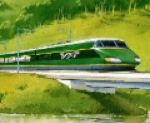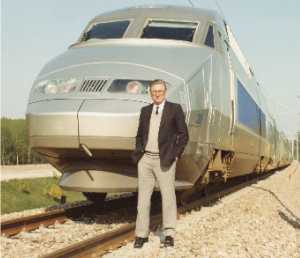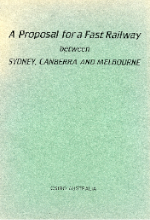Australia’s Very Fast Train (VFT) project, 1984 to 1991
(A comprehensive Wikipedia article describing the VFT project and other achievements of Dr Paul Wild should be read in conjunction with the following remarks, which are by former members of the project.)
The VFT (Very Fast Train) Project was a visionary proposal in 1984 by CSIRO chairman Dr Paul Wild to run trains, much like TGVs, between Sydney and Melbourne via Canberra. The project became a private-sector joint venture in 1987. It almost succeeded, but collapsed in 1991 when the federal government declined to initiate a tax policy that would have resulted in higher tax being paid over all but with less tax at the beginning of the project when major outlays would occur. Ironically, the federal government soon introduced infrastructure bonds to assist major projects facing the same financial hurdles as the VFT. However, Australian governments have continued to struggle to find acceptable mechanisms for public–private partnerships undertaking infrastructure projects.
Dr Paul Wild, instigator of the VFT project, during a visit to France in 1989 in which he and his colleagues discussed the project with officials of SNCF and Alstom. The following year, a TGV trainset similar to this one set a world wheel-on-rail speed record of 515.3 km/h; the current (3 April 2007) record is 574.8 km/h (357.16 mph).
[Photo © A. John Nicolson 1989. It is available for download and unrestricted re-use under a Creative Commons Attribution–ShareAlike 3.0 licence.]
Developments in the past 20 years
In 1993, the Speedrail Consortium (a joint venture between Alstom and Leighton Holdings) proposed a high-speed rail link between Sydney and Canberra. In 1998 the Australian Government approved the project to move to the “proving up” stage subject to its being at "no net cost to the taxpayer". The line was to operate under a build–own–operate model, transferring to government ownership after 30 years. In 2000 the Australian Government terminated the proposal, citing fears it would require excessive subsidies.
High-speed rail options for eastern Australia are currently being studied by the Australian Government. The most recent (April 2013) consultant report gives a cost estimate (in 2012 Australian dollars) for a Brisbane–Melbourne line of about $114 billion, with the Sydney–Melbourne component (to be built first) being about $50 billion and Sydney–Brisbane being about $64 billion.
In comparison, the estimated capital cost of the VFT project for Sydney–Melbourne in 1990 was $16 billion (about $28 million in 2012 dollars); in 1989 the Sydney–Brisbane estimate was “slightly less in real terms than for Melbourne–Sydney”. The costs of tunnelling and land acquisition necessary to enter the capital cities are a significant part of this increase: state governments ignored the VFT Joint Venture’s recommendation to reserve the surface route approaching the major city centres in readiness for any future initiatives.
This doubling, approximately, of the construction costs has led to a conclusion by the 2013 report that “Governments would be required to fund the majority of the upfront capital costs”, in contrast to the VFT proposition of funding by the private sector.
Some strategic decisions of the 2013 report are questionable. For example, selection of an inland route south of Canberra ignores a demographic reality. Not many Australians prefer to live far inland: about 80 per cent of the population resides within 50 kilometres of the sea. Under the original VFT concept, a route was chosen south of Canberra that was within easy access of the coast of south-eastern New South Wales and eastern Victoria. One reason was the coastal region’s huge potential for decentralisation: it is a lightly populated area, still with relatively poor infrastructure. However, towards the end of the project the VFT Joint Venture decided to follow an inland route south of Canberra because it was slightly cheaper and governments had shown no interest in decentralisation. The current Australian Government study also prefers an inland route south of Canberra. If a high-speed rail line is built there, the location, and factors such as limitations in water supplies, will limit the potential for decentralisation compared with a near-coastal route.
Paul Wild said in 1984 that "in many areas Australia needed desperately to dig itself out of the stagnation of 19th century thought." This seems truer than ever for the most recent proposal, which does not envisage becoming operational between Sydney and Melbourne until 2040 or between Sydney and Brisbane until 2058. Such a laughable timeframe invites a conclusion that the Australian Government has no intention of implementing the project. If the timeframe is serious, it reflects a lamentable shortsightedness. The lack of a visionary of the calibre of Dr Wild and of decisive political leadership at national and state levels is likely to condemn Australia to further studies but nothing else.
When Dr Wild conceived the idea of the VFT, only three countries were running trains at more than 200 km/h on purpose-built tracks: France, Japan and Italy. If the VFT project had advanced reasonably quickly, Australia would have been about the sixth country in the world to have high-speed rail, after Germany and Spain. Today, high speed rail services are operating in about a dozen countries, and a similar number are building or planning them. Australia has dropped far behind.
Meanwhile, the Sydney–Canberra train, the one that in 1984 prompted Paul Wild to offer help to improve it, still runs at about the same average speed, 81.6 km/h, as the London–Bristol Express of 1851.
Documents related to the VFT
The initial proposal, written by CSIRO chairman Dr Paul Wild and Dr John Brotchie and Dr John Nicolson, also of CSIRO, was A proposal for a fast railway between Sydney, Canberra and Melbourne, published on 26 July 1984. A PDF is available for viewing or downloading here.
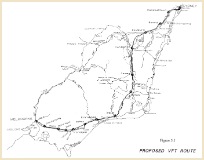
Click to view or download a map of the route as initially plotted by Dr Wild’s team.
Click on the cover images of all but the first of these major VFT reports to be taken to the National Library of Australia’s Trove website, where locations of library copies in Australia are given. (The first, i.e. the VFT Pre-feasibility study report, is not available through libraries.)
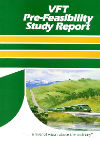

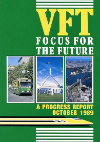
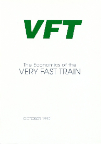
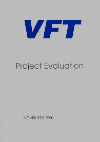
To aid evaluation of each report’s relevance to research needs, the table of contents and the summary or introductory chapter of the reports are available here for viewing or downloading:
VFT pre-feasibility study report of June 1987
VFT Concept Report of December 1988
VFT, Focus for the future: a progress report of October 1989
The Economics of the Very Fast Train of October 1990
VFT project evaluation of November 1990
Dr Wild and Dr Brotchie produced a report, VFT-N: the Sydney–Brisbane VFT, in March 1989. A PDF is available for viewing or downloading here.
In 1990, the VFT Joint Venture published hard-copy information sheets under the title of VFT Topics. Misinformation about high-speed rail travel was widespread, so they were written to provide comprehensive information concerning key concepts. About 20 topics were envisaged. The first five, covering some of the more important subjects, had been published when a sudden decision was made to provide such information in a new periodical, VFT News, rather than in VFT Topics. It is for this reason that there were gaps in the numbering of the issues, as reflected in the following list. However, public demand continued to be high and the five were re-printed several times. By the time the project had ended, no other information sheets had been published and coverage in VFT News had been scant.
The five published issues (ISSN 1034-3962) and one final draft can be viewed and downloaded here:
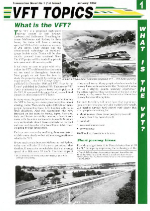
VFT Topics No. 1: What is the VFT?
VFT Topics No. 2: High-speed trains overseas
VFT Topics No. 3: The VFT’s origins
(Unpublished. The Chairman of the Joint Venture, Dr Paul Wild, had approved the final draft of this information sheet, which was based in large measure on interviews with him, but in the event it had not proceeded to publishing before the VFT project ended.)
VFT Topics No. 4: Timetables and fares
VFT Topics No. 7: VFT and the environment
VFT Topics No. 13: Selecting the route
IMPORTANT: COPYRIGHT
The Very Fast Train Project, after it moved from the stewardship of CSIRO, operated as a joint venture from 1987. As such it was not incorporated as a distinct corporate entity. The joint venture is no longer extant, having been wound up in 1991. Not all of the companies that formed the joint venture now remain in the same corporate form. Current ownership of copyright in works published by the VFT Joint Venture is therefore obscure. In view of this, material on this page is provided solely for the purpose of fair dealing under the provisions of the Commonwealth of Australia Copyright Act 1968. (Readers in the US should note that “fair dealing” is different from the “fair use” that governs some forms of re-use of copyright works in that country. You should consult the Act and guidance from the Copyright Council of Australia , and obtain legal advice if necessary, to make sure that you do not transgress copyright.)

